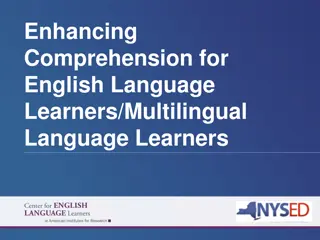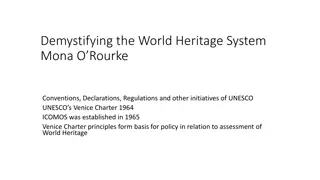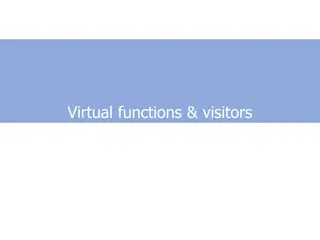Teaching Strategies for Heritage Language Learners in Mixed Classes
Explore essential concepts in teaching heritage language learners in mixed classes, focusing on project-based teaching. Understand the characteristics of native speakers, heritage speakers, and second language learners. Learn about the motivations of heritage language learners and the implications for teaching and learning, including how and what to teach for different learner groups.
Download Presentation

Please find below an Image/Link to download the presentation.
The content on the website is provided AS IS for your information and personal use only. It may not be sold, licensed, or shared on other websites without obtaining consent from the author.If you encounter any issues during the download, it is possible that the publisher has removed the file from their server.
You are allowed to download the files provided on this website for personal or commercial use, subject to the condition that they are used lawfully. All files are the property of their respective owners.
The content on the website is provided AS IS for your information and personal use only. It may not be sold, licensed, or shared on other websites without obtaining consent from the author.
E N D
Presentation Transcript
Principles and Strategies for Teaching HL Learners: Focus on mixed classes Maria M. Carreira, Ph.D. Professor of Spanish California State University, Long Beach Co-director National Heritage Language Resource Center, UCLA
Overview of this presentation Essential concepts in HL teaching; Mixed classes; Project based teaching;
FirstIntroductions Name Language Level One goal for this workshop
Overview of this presentation Essential concepts in HL teaching; Mixed classes; Project based teaching;
Essential characteristics Native speakers Heritage speakers Second language speakers
Heritage Language Learners Foreign Language Learners Native Speakers Language Use Family Yes Yes No Range of interaction Full Limited Limited Formal education in the target language Yes Varies Yes Needs vis- -vis the target language To function in society ? ?
HL learner motivations Top reasons why HLLs study their HL: Professional reasons (Spanish, Chinese, Japanese); Finding identity; Communicating with family and friends in the U.S.; Communicating with speakers of the HL outside the U.S.; Carreira and Kagan (2011)
Implications for teaching and learning Heritage speakers L2 Native speakers learners
Implications for teaching and learning How we teach What we teach; Why we teach; Native speakers Heritage speakers
Implications for teaching and learning How we teach; What we teach; Why we teach; L2 learners Heritage speakers
Discussion: How we teach Papa who wakes up tired in the night How would you use this reading with native speakers? How would you use this reading with L2 learners?
What and how we teach Engaging with a reading and completing an authentic task using level-appropriate vocabulary and grammatical constructions Goals of instruction Macro/Top Down Micro/Bottom Up A reading or authentic task A reading or authentic task Pathway to meeting learning goals) Form- focused instruction Form- focused instruction
Teaching domain Macro-based Micro-based Vocabulary and grammar Age-appropriate and integrated. Dictated by function and context. Carefully controlled and selected. Isolated practice of different aspects of linguistic knowledge. Reading Fairly large and complex texts from the beginning. Unaltered authentic texts. Small texts gradually increasing in volume and complexity. Altered texts to facilitate readability. Writing Longer texts from the beginning. Initial emphasis on the content, gradually building toward improving stylistics, grammar, spelling. Sentence level gradually increasing to paragraph and then longer. Speaking and listening Full range of native input (movies, documentaries, lectures, news stories, plays, etc.) and output (discussions, conversations, monologues) Initially restricted, gradually increasing in length and complexity. Initially restricted to dialogue. Culture Full range of topics, integrated. Initially isolated and decontextualized.
Sample macro activities (Richards, 1990, 61-63 ) Guess what news headlines might refer to, then listen to or read the complete piece; Identify a picture from a description of it; Identify key ideas in a message; Listen to conversations containing small talk and recognize when the speaker is preparing to introduce a real topic; Read information about a topic, then listen to a talk on the topic and check whether the information was mentioned or not;
Practice Papa who wakes up tired in the night How would you use this reading using a macro approach? How would you use this reading using a micro approach?
Teaching domain Macro-based Micro-based Vocabulary and grammar Age-appropriate and integrated. Dictated by function and context. Carefully controlled and selected. Isolated practice of different aspects of linguistic knowledge. Reading Fairly large and complex texts from the beginning. Unaltered authentic texts. Small texts gradually increasing in volume and complexity. Altered texts to facilitate readability. Writing Longer texts from the beginning. Initial emphasis on the content, gradually building toward improving stylistics, grammar, spelling. Sentence level gradually increasing to paragraph and then longer. Speaking and listening Full range of native input (movies, documentaries, lectures, news stories, plays, etc.) and output (discussions, conversations, monologues) Initially restricted, gradually increasing in length and complexity. Initially restricted to dialogue. Culture Full range of topics, integrated. Initially isolated and decontextualized.
Learners for this approach? Macro/Top Down Pathway to meeting learning goals) A reading or authentic task Form- focused instruction Native speakers, HL learners, advanced L2 learners
What about micro-based teaching? Micro/Bottom up Pathway to meeting learning goals) A reading or authentic task Form- focused instruction L2 learners at the lower levels of proficiency, HL learners (sometimes)
Back to macro-based teaching Macro/Top Down Pathway to meeting learning goals) A reading or authentic task Form- focused instruction Native speakers, HL learners
Macro approaches: Native vs. heritage learners How to use them; What materials to use;
Macro approaches: Native vs. heritage learners How to use them; Scaffolding What materials to use; Content Level
Scaffolding Scaffolding provides critical support for effective macro-based teaching and the use of authentic materials and tasks;
Scaffolding: Key concepts Building; Supporting A step-by-step approach;
Scaffolding in the classroom Scaffolding can include modeling a skill, providing hints or cues, tapping into background knowledge, breaking a task into small, more manageable tasks with opportunities for intermittent feedback (Copple & Bredekamp, 2009).
A model of scaffolding for HL teaching: From-to principles (Olga Kagan) Listening -> Reading Speaking -> Writing Home-based register -> General and academic registers Everyday real-life activities -> Classroom activities HL learners motivations surrounding identity and group membership -> content
Other configurations that also serve to scaffold and build Speaking Listening Writing Reading
Practice Papa who wakes up tired in the night Question: How would you use one of the From- to principles with this reading?
A model of scaffolding for HL teaching: From-to principles (Olga Kagan) Listening -> Reading Speaking -> Writing Home-based register -> General and academic registers Everyday real-life activities -> Classroom activities HL learners motivations surrounding identity and group membership -> content
A model of scaffolding for HL teaching: From-to principles (Olga Kagan) Listening -> Reading Speaking -> Writing Home-based register -> General and academic registers Everyday real-life activities -> Classroom activities HL learners motivations surrounding identity and group membership -> content
Macro approaches: Native vs. heritage learners How to use them; Scaffolding What materials to use; Content Level
Socio-affective issues Serve to differentiate HL learners from native speakers and L2 learners; Often relate to the challenges of balancing two different cultures and living between worlds; Are a critical component of HL teaching/learning
Socio-affective issues In high school I was one of very few Latinos. My friend and I were called the American kids. This was always funny to me because my Dad s family always told me I was American. In school I was labeled Mexican, but to the Mexicans, I am an American. I am part of each, but not fully accepted by either. It s this weird duality in which you are stuck in the middle You take pride in both cultures and learn to deal with the rejection. You may never be fully embraced by either side. That s why you seek out other people like yourself. Socializing with people who share a common experience helps you deal with this experience. (Carreira & Beeman, 2014, p. 88)
Activity: Finding HL appropriate content What themes and topics that are likely to be engaging to HL learners in your reading? CAUTION: This may take some creativity e.g. Little Red Riding Hood Grandma living alone? Little girl being allowed to walk alone through the forest?
Macro approaches: Native vs. heritage learners How to use them; Scaffolding What materials to use; Content Level
Readings What in the way of content is particularly well suited for HL learners? What about level? Is it appropriate? How can you scaffold this reading? How can you use the From-to principles?
From-to Principle: Listening -> Reading From To Listening to a dinner conversation? Listening to a political debate? Listening to a UN speech? Reading a recipe? Reading an academic paper? Reading a novel?
Scaffolding From To
From-to Principles From To
Vygotskys Zone of Proximal Development (ZDP) The ZPD is the difference between what a child can do independently and what he or she is capable of doing with targeted assistance (e.g. scaffolding). In terms of thinking about level -> Aim for the ZPD
To keep in mind Knowledge that is beyondthe learners ZPD will not likely be grasped, even with extensive scaffolding. Knowledge that is underthe learners ZPD will not lead to learning.
Mixed classes: Problem 1 Engaging with the reading, movie, etc., and completing an authentic task using level-appropriate vocabulary and grammatical constructions Goals of instruction Macro/Top Down Micro/Bottom Up Preferred instructional approach A reading or authentic task A reading or authentic task (i.e. pathway to meeting learning goals) Form- focused instruction Form- focused instruction HL learners L2 learners
Mixed classes: Problem 2 HL learners 1. Listening -> Reading 2. Speaking -> Writing 3. Home-based register -> General and academic registers 4. Everyday real-life activities -> Classroom activities 5. HL learners motivations surrounding identity and group membership -> content L2 learners 1. Reading -> listening 2. Writing - > speaking 3. General and academic registers-> Home-based register 4. Classroom activities -> Everyday real-life activities 5. Motivations?
Mixed classes: Problem 3 Content: HL themes v. L2 themes
Summary HL learners are like native speakers with regard to some aspects of the target language and like L2 learners with regard to other aspects; Macro- v. micro-based teaching; The From-to principles can help scaffold instruction; Vigotsky s ZPD can guide the crafting of learning goals and activities.
Overview of this presentation Essential concepts in HL teaching; Mixed classes; Project based teaching;
References Carreira, M. & Beeman, T. (2014). Voces: Latino students on life in the United States. Santa Barbara, CA: Praeger. Carreira, M. (in press). Supporting Heritage Language Learners Through Macro-based approaches. In S. Beaudrie and M. Fairclough (eds.) Innovative Approaches in HL Pedagogy: From Research to Practice. Georgetown University Press. Copple, C., & Bredekamp, S. (2009). Developmentally appropriate practice. Washington, DC: National Association for the Education of Young Children.
References (cont.) Richards, J. C. (1990). The Language Matrix. Cambridge: Cambridge University Press. Vygotsky, L. S. (1978). Mind in society: The development of higher psychological processes. Cambridge, MA: Harvard University Press.























